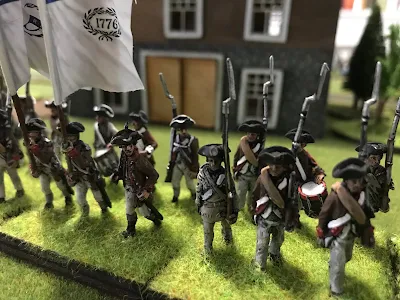 |
Reading is a dangerous thing. Especially for those of us with butterfly tendency. After reading, and rereading "The Road to Charleston " I have taken a real interest in the period from April to September 1781 in South Carolina. While not as well know as the time period between Camden and Guilford Courthouse it is nevertheless a fascinating petiod. Plus for the table top a most interesting variety of troop types. State Line, Militia and Continental. Rifles, legion infantry and rangers. Mounted infantry, mounted militia and regular cavalry.
 |
| New York Volunteers Regiment near completion. Waiting for colors To arrive and based To be flocked. |
To start this new theater I am raising a Loyalist brigade. Based around Lord Rawdon's forces at Hobkirk Hill these will include Volunteers of Ireland, King's American Regiment, New York Volunteers and South Carolina Royalists. The Provincial Light Infantry battalion will not be painted, but will be represented by other units in my collection. I would like to raise Captain Coffin's mounted company of the New York Volunteers and am studying returns of equipment scalable to make a educated guess at what they were wearing. Although I am not planning on raising any addition American Regiments for Greene's army additional rifle units and militia are always needed. We will see!
In addition I have been working on the British 20th and 62nd regiments from the Saratoga campaign. These are new figures from Fife and Drum miniatures. They look great but are coming along very slowly.
 |
| Start of the 20th Regiment of Foot. |
Lastly I am working on a game based on the Battle of Hobkirk Hill. I think this has the potential to be a interesting game. I am using the actual order of battle; but increasing the size of the regiments. In addition both sides have posts able reinforcements that may (or may not) arrive to help. Stay tuned for more to come

















































